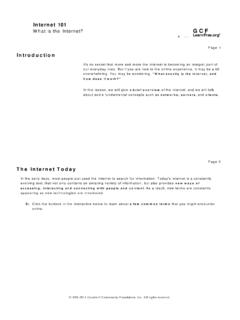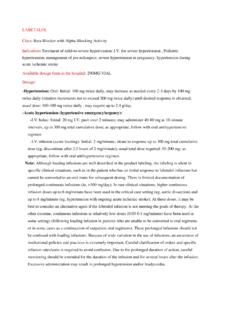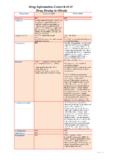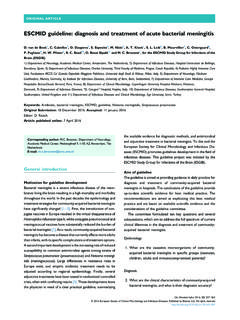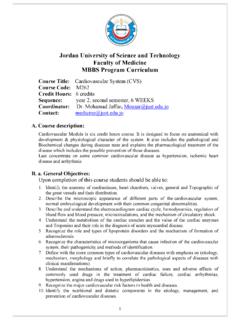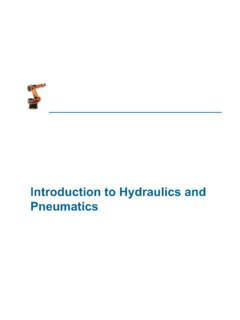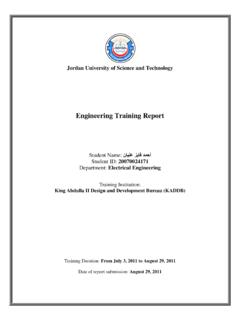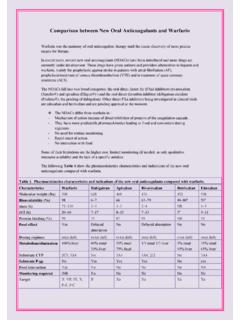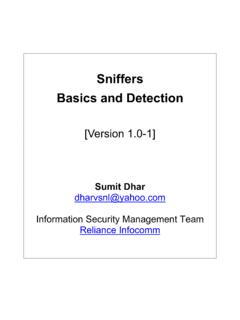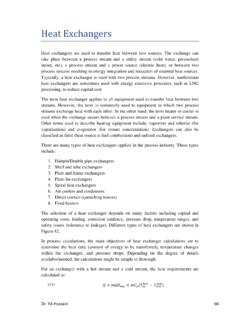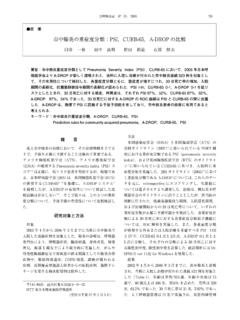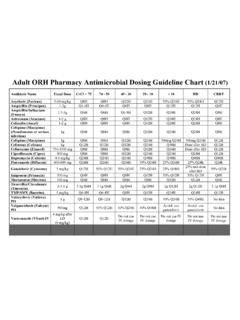Transcription of Vancomycin - Jordan University of Science and …
1 Vancomycin : Class: Antibiotic. Indications: Treatment of patients with infections caused by staphylococcal species and streptococcal Species. Available dosage form in the hospital: 1G VIAL, 500MG VIAL. Dosage: -Usual dosage range: Initial intravenous dosing should be based on actual body weight;. subsequent dosing adjusted based on serum trough Vancomycin concentrations. : 2000-3000 mg/day (or 30-60 mg/kg/day) in divided doses every 8-12 hours (Rybak, 2009); Note: Dose requires adjustment in renal impairment -Indication-specific dosing: -Catheter-related infections: Antibiotic lock technique (Mermel, 2009): 2 mg/mL 10.
2 Units heparin/mL or mg/mL 2500 or 5000 units heparin/mL or 5 mg/mL 5000. units heparin/mL (preferred regimen); instill into catheter port with a volume sufficient to fill the catheter (2-5 mL). Note: May use SWFI/NS or D5W as diluents. Do not mix with any other solutions. Dwell times generally should not exceed 48 hours before renewal of lock solution. Remove lock solution prior to catheter use, then replace. -Complicated infections in seriously-ill patients: : Loading dose: 25-30 mg/kg (based on actual body weight) may be used to rapidly achieve target concentration; then 15-20.
3 Mg/kg/dose every 8-12 hours (Rybak, 2009). associated diarrhea (CDAD): -Oral: -Manufacturer recommendations: 125 mg 4 times/day for 10 days -IDSA guideline recommendations: Severe infection: 125 mg every 6 hours for 10- 14 days; Severe, complicated infection: 500 mg every 6 hours with or without concurrent metronidazole. May consider Vancomycin retention enema (in - patients with complete ileus) (Cohen, 2010). -Rectal (unlabeled route): Retention enema (in patients with complete ileus): SHEA/IDSA guideline recommendations: Severe, complicated infection in patients with ileus: 500 mg every 6 hours (in 100 mL sodium chloride) with oral Vancomycin with or without concurrent metronidazole (Cohen, 2010).
4 -Enterocolitis (S. aureus): Oral: 500-2000 mg/day in 3-4 divided doses for 7-10 days (usual dose: 125-500 mg every 6 hours). -Group B streptococcus (neonatal prophylaxis): : 1000 mg every 12 hours until delivery. Note: reserved for penicillin allergic patients at high risk for anaphylaxis if organism is resistant to clindamycin or where no susceptibility data are available (CDC, 2010). -Meningitis: : 30-60 mg/kg/day in divided doses every 8-12 hours (Rybak, 2009) or 500-750 mg every 6 hours (with third-generation cephalosporin for PCN-resistantStreptococcus pneumoniae).
5 -Alternate regimen: S. aureus (methicillin-resistant) (unlabeled use; Liu, 2011): 15-20 mg/kg/dose every 8-12 hours for 2 weeks (some experts combine with rifampin -Intrathecal, intraventricular (unlabeled route): 5-20 mg/day -Pneumonia: : -Community-acquired pneumonia (CAP): S. aureus (methicillin-resistant): 45-60. mg/kg/day divided every 8-12 hours (maximum: 2000 mg/dose) for 7-21 days depending on severity (Liu, 2011). -Healthcare-associated pneumonia (HAP): S. aureus (methicillin-resistant): 45-60. mg/kg/day divided every 8-12 hours (maximum: 2000 mg/dose) for 7-21 days depending on severity (American Thoracic Society [ATS], 2005; Liu, 2011; Rybak 2009).)
6 -Prophylaxis against infective endocarditis: : -Dental, oral, or upper respiratory tract surgery: 1000 mg 1 hour before surgery. Note: AHA guidelines now recommend prophylaxis only in patients undergoing invasive procedures and in whom underlying cardiac conditions may predispose to a higher risk of adverse outcomes should infection occur -GI/GU procedure: 1000 mg plus mg/kg gentamicin 1 hour prior to surgery. Note: As of April 2007, routine prophylaxis no longer recommended by the AHA. -Susceptible (MIC 1 mcg/mL) gram-positive infections: : 15-20 mg/kg/dose (usual: 750-1500 mg) every 8-12 hours (Rybak, 2009).
7 Note: If MIC 2 mcg/mL, alternative therapies are recommended. -Bacteremia (S. aureus [methicillin-resistant]) (unlabeled use; Liu, 2011): : 15-20. mg/kg/dose every 8-12 hours for 2-6 weeks depending on severity -Brain abscess, subdural empyema, spinal epidural abscess (S. aureus [methicillin- resistant]) (unlabeled use; Liu, 2011): : 15-20 mg/kg/dose every 8-12 hours for 4- 6 weeks (some experts combine with rifampin). -Endocarditis: -Native valve (Enterococcus, Vancomycin MIC 4 mg/L) (unlabeled use; Gould, 2012): : 1000 mg every 12 hours for 4-6 weeks (combine with gentamicin for 4-6 weeks).
8 -Native valve (S. aureus [methicillin-resistant]) (unlabeled use; Liu, 2011): : 15-20. mg/kg/dose every 8-12 hours for 6 weeks (European guidelines support the entire duration of therapy to be 4 weeks and in combination with rifampin [Gould, 2012]). -Native or prosthetic valve (streptococcal [penicillin MIC > mg/L or patient intolerant to penicillin]) (unlabeled use; Gould, 2012): : 1000 mg every 12. hours for 4-6 weeks (combine with gentamicin for at least the first 2. weeks); Note: The longer duration of treatment (ie, 6 weeks) should be used for patients with prosthetic valve endocarditis.
9 -Prosthetic valve (Enterococcus, Vancomycin MIC 4 mg/L) (unlabeled use; Gould, 2012): : 1000 mg every 12 hours for 6 weeks (combine with gentamicin for 4-6. weeks). -Prosthetic valve (S. aureus [methicillin-resistant]) (unlabeled use; Liu, 2011): : 15- 20 mg/kg/dose every 8-12 hours for at least 6 weeks (combine with rifampin for the entire duration of therapy and gentamicin for the first 2 weeks). -Endophthalmitis (unlabeled use): Intravitreal: Usual dose: 1 mL NS instilled into vitreum; may repeat administration, if necessary, in 2-3 days, usually in combination with ceftazidime or an aminoglycoside (Kelsey, 1995).
10 Note: Based on concerns for retinotoxicity, some clinicians have recommended using a lower dose of ;. may repeat in 3-4 days, if necessary (Gan, 2001). -Osteomyelitis (S. aureus [methicillin-resistant]) (unlabeled use; Liu, 2011): : 15-20. mg/kg/dose every 8-12 hours for a minimum of 8 weeks (some experts combine with rifampin). -Prosthetic joint infection (unlabeled use; Osman, 2013): : Adults: -Enterococcus spp (penicillin-susceptible or resistant), Propionibacterium acnes, streptococci (beta-hemolytic): 15 mg/kg every 12 hours for 4-6 weeks, followed by an oral antibiotic suppressive regimen Note: For penicillin-susceptible or -resistant Enterococcus spp, consider addition of an aminoglycoside; in penicillin-susceptible Enterococcus, beta-hemolytic streptococcus or Propionibacterium acnes infections, only use Vancomycin if patient has penicillin allergy.
